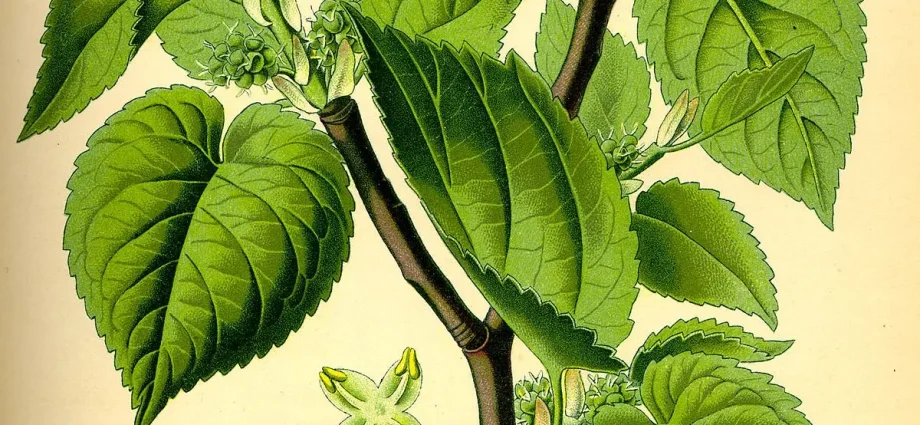Contents
Black mulberry is common in Asian countries, but is increasingly found in the middle lane. It is valued for its tasty and healthy berries. For successful cultivation of mulberries, it is important to choose a suitable place and regularly care for the crop.
Description of black mulberry
Black mulberry is a deciduous tree, belongs to the genus Mulberry and the Mulberry family. It is also known also under the names mulberry, here, mulberry tree. The culture comes from Southwest Asia, from where it gradually spread to the west. The life span of a mulberry tree is up to 200 years.
Mulberry is grown for its useful edible fruits. Its wood is dense and heavy, used for the manufacture of musical instruments, furniture, building materials. In Our Country, harvesting mulberry wood is prohibited by law. The leaves of the tree serve as a food source for silkworms, which are used to make silk.
Mulberry reaches a height of 10 – 13 m. Leaves 10 to 20 cm long, elongated, green in color. The fruits are dark purple, almost black. They consist of many drupes 2 to 4 cm long. Outwardly, the berries resemble blackberries. Black mulberry fruits are edible, sweet in taste, with a sour taste.
You can evaluate the appearance of the culture by the photo of the black mulberry tree:
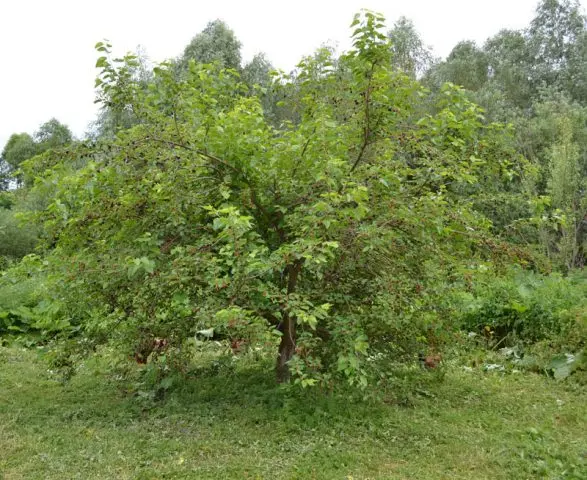
When growing black mulberry in Central Our Country, the tree often freezes slightly, but quickly recovers. After pruning, the culture is grown as a shrub. Black mulberry tolerates urban gas pollution well and is suitable for planting in parks.
How black mulberry blooms
In the southern climate, the mulberry blossoms in April, in the Middle lane – in May or June. The pollen of the plant is carried by the wind, as well as by insects. Mulberry belongs to dioecious plants. The female and male flowers are on different trees. Therefore, at least 2 mulberry trees are planted to form a crop. Some cultivated varieties have both types of inflorescences and do not need pollinators.
What is useful black mulberry
Mulberry fruits are rich in useful substances. The calorie content of the product is low: 50,4 kcal per 100 g. Black mulberry is used for weight loss and in the diet menu for the treatment and prevention of various diseases. It well removes toxins from the body, gently cleanses the intestines.
The benefits of black mulberry are explained by its composition, which includes:
- resveratrol – a plant antioxidant that protects against the spread of bacteria and fungus;
- vitamins A, B1, B3, C, PP, K;
- beta-carotene;
- potassium, calcium, magnesium, sodium, zinc, selenium, iron;
- organic acids;
- mono- and disaccharides.
The fruits of the plant are valued for their high content of potassium. They also have a diuretic, choleretic effect, successfully relieve inflammation. They are also taken for edema, heart defects, to relieve pain, shortness of breath. Unripe berries are also used for diarrhea, as they have an astringent effect. Ripe fruits help with constipation.

Mulberry leaves in the form of a decoction produce an antipyretic effect. Fresh juice from the leaves relieves toothache. Berry extract is effective for colds, beriberi, low immunity, disorders of the nervous system.
Black mulberry bark also has useful properties. Decoctions based on it are used for kidney disease. Powder from the bark promotes healing of wounds and burns. An infusion of the roots is useful for bronchial asthma and colds, hypertension, heart disease.
Varieties of black mulberry
All varieties of black mulberry have dark-colored bark and berries. Most varieties give a high yield and are adapted to various conditions.
Mulberry black Nadia
Mulberry Nadia has the appearance of a medium-sized tree. The variety has high winter and drought resistance. Black mulberry is unpretentious to the composition of the soil, but does not tolerate stagnant moisture. The flowering of the tree begins in May. Extended fruit ripening: from mid-July to autumn.
The fruits are purple, almost black, not very large. The length of the berries leaves 2,5 – 3 cm. The fruits taste pleasant, sweet and sour. A bountiful harvest is harvested 3-4 years after planting. At the same time, up to 15 kg of berries are removed from the tree. Mulberry has a dessert purpose and is well suited for processing.
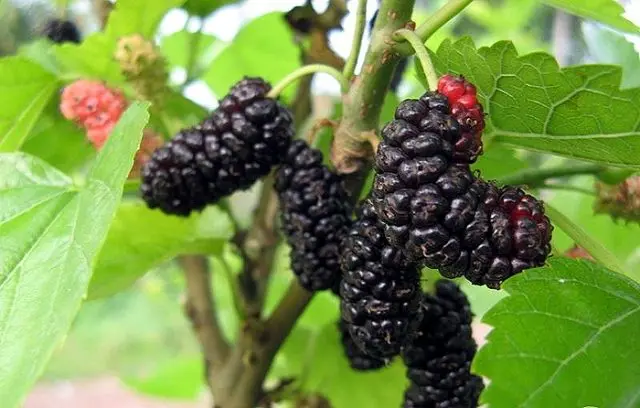
Mulberry Black Prince
According to the description, the Black Prince variety mulberry is a tree up to 10 m high with a wide crown. The culture is distinguished by especially large fruits up to 5 cm long. The color of the berries is black, the surface is shiny. The taste is pleasant, sweet and sour. The leaves are powerful, asymmetrical in shape with notches along the edges.
Mulberry variety Black Prince blooms in April – May. Fruiting begins in the second half of summer. The yield from one mulberry tree is up to 100 kg. Berries are stored for 2 – 3 days. For the formation of ovaries, a pollinator is needed that blooms at similar times. Mulberry Black Prince is unpretentious to growing conditions and is suitable for planting in the northern regions.

Admiralskaya
Mulberry Admiralskaya was included in the State Register in 2017. This is a late ripening variety, the purpose of its berries is universal. The mulberry tree is sprawling, of great growth strength, forms a powerful trunk with dark gray bark. Its shoots are straight, green. The leaves of the variety are matte, medium in size, have an ovoid shape.
The fruits of the variety have a mass of up to 1,7 g, a cylindrical shape, black in color, covered with a thin skin. The sugar content is 19,2%. The taste is sweet, with refreshing notes. Variety Admiralsky is resistant to drought and winter frosts. No damage by diseases or pests was found.
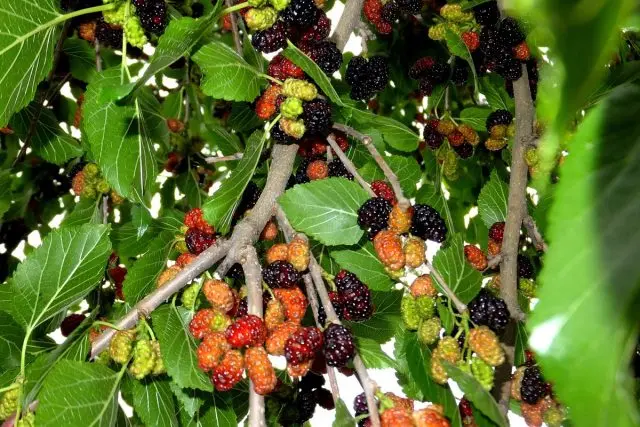
Royal
Royal – one of the large-fruited varieties of black mulberry. The tree is medium-sized, up to 8 m high, forms a thickened spreading crown. The leaves are glossy, green in color. Fruits reach a weight of 20 g and a length of 6 cm. Taste qualities are rated at a high level. The shelf life of berries is several days.
Variety Royal comes into fruiting early and yields a crop in the first year after planting. Ripening early: begins in early June. Mulberry is resistant to frost, tolerates summer drought well.
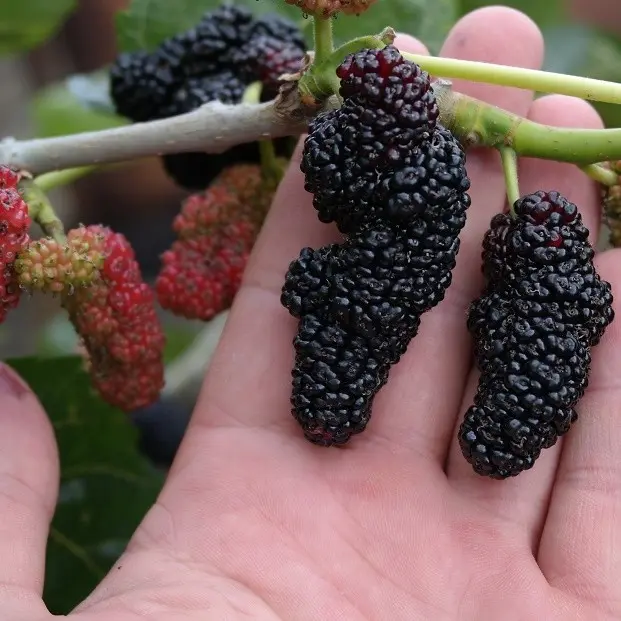
Istanbul Black
Mulberry Istanbul Black is one of the large-fruited varieties. The tree reaches a height of 7 m. The crown is dense and decorative. Fruiting begins at 2 or 3 years. The flowers are collected in inflorescences in the form of an ear. The leaves are green, ovoid.
The mulberry blossoms in the last decade of April. The variety belongs to late and self-pollinated. The ripening period starts from the end of July and lasts until August. The fruits are dark, almost black, 3 cm long. The taste is sweet, with a barely perceptible sourness.
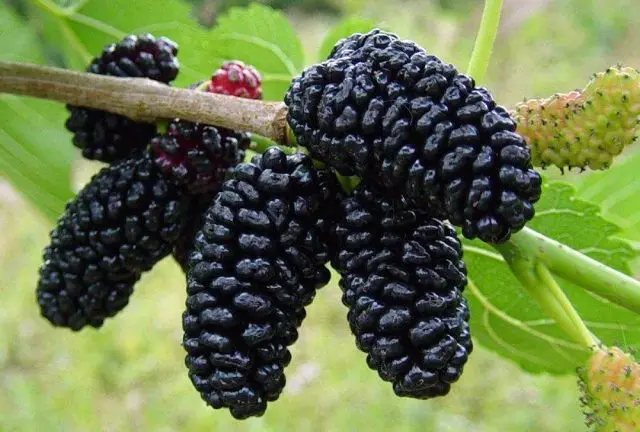
Staromoskovskaya
Mulberry Staromoskovskaya is a tree with a spherical crown. The height of the mulberry tree is up to 10 m. Due to pruning, it is grown in the form of a shrub or weeping willow. The fruits are 2-3 cm long, dark purple to almost black in color. The taste is sweetish, with a slight sourness.
Variety Staromoskovskaya is resistant to winter frosts. The culture does not get sick, quickly adapts to any weather conditions. The mulberry tree is self-fertile: its crop is formed without the participation of pollinators.
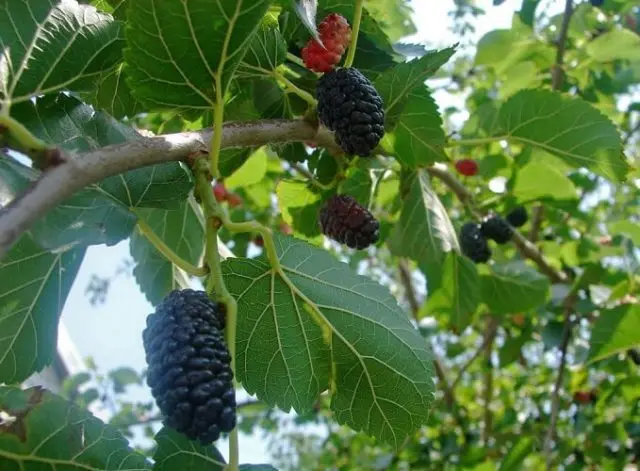
Black pearl
Mulberry Black Pearl is a tall tree with a spherical crown. When pruning the central conductor, the mulberry tree is grown in the form of a bush. Then the shoots reach a height of 3,5 m. The leaves of the plant are dark green, large, the crown is brown with a reddish tint. Fruiting takes place in June – July.
Mulberry variety Black Pearl brings a high yield. Up to 100 kg of berries are removed from the tree. The fruits are purple-black in color, up to 4 cm long and weighing up to 9 g. They taste sweet and sour. When ripe, the berries crumble, so it is recommended not to delay harvesting or lay a film under the tree.

Growing and caring for black mulberry
To benefit from the black mulberry, it is important to find a suitable place for it. During cultivation, the tree is provided with constant care.
Selection and preparation of the landing site
In order for the mulberry to develop and bear fruit, a specific place is chosen for planting. The culture is photophilous, it is placed in a sunny area. Be sure to provide protection from the cold wind in the form of buildings or other plantings.
Basic soil requirements:
- looseness;
- fertility;
- lack of moisture stagnation;
- groundwater level below 1,5 m.
Mulberry does not tolerate saline and waterlogged soils. Clay and sandy soil is not suitable for planting. If the earth is heavy, then a drainage layer of expanded clay is made in the landing pit. The addition of humus and clay also helps to improve the composition of sandy soil.
For planting choose two- or three-year-old seedlings. Plants are purchased from a nursery. Before buying, mulberry should be inspected. Seedlings without cracks, mold and other defects are suitable for planting.
Rules of landing
Mulberries are planted in April or late autumn. Choose a period when sap flow slows down in trees. In the south, it is better to plant the plant in October – November, so that the culture has time to adapt before the cold weather. In the middle lane and in the north, where there are early frosts, planting is left for spring. Pit preparation begins 3 to 4 weeks before planting. It is left to shrink, which can seriously damage the seedling.

The order of planting mulberries:
- First, they dig a pit with a diameter of 50 cm to a depth of 60 cm.
- To fill the pit, a substrate is obtained: 5 kg of compost and 100 g of superphosphate.
- After shrinkage, an earthen mound is formed in the pit.
- The seedling is placed on top. The roots are straightened and poured on top of the soil.
- The soil is compacted and watered abundantly.
The order of landing does not depend on the period of work. The seedling is tied to a support, and a layer of humus is poured into the near-trunk circle for mulching.
Watering and top dressing
Mulberry tolerates a short drought well. If precipitation often falls in the region, then moisture can be dispensed with. The mulberry tree is watered only in severe drought. Water is needed from April to July. When growing black mulberry, warm settled water is used. It is introduced strictly into the trunk circle, it is best to choose morning or evening hours.
Mulberry responds positively to fertilization. In the spring, it is watered with a solution of urea or mullein. They contain nitrogen, which promotes the growth of green mass. When the plant blooms and fruits ripen, superphosphate and potassium are added. These substances improve the taste and quality of berries. For 10 liters of water, it is enough to add 40 g of each fertilizer.
Trimming
The mulberry tree is pruned during the dormant period. This period occurs in early spring or late autumn. Best of all, the tree tolerates processing in spring: in late April or early May, when the leaves have not yet blossomed.
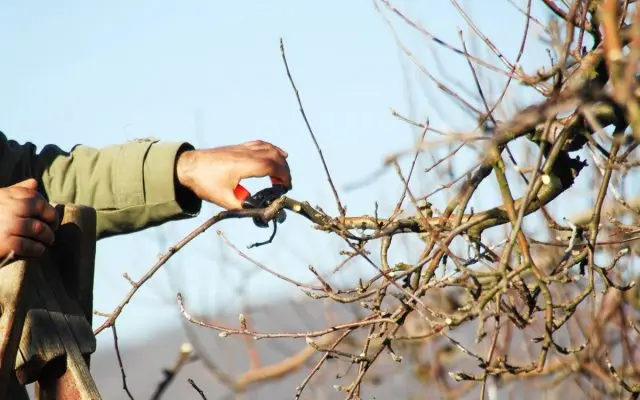
In a young black mulberry, branches are completely removed at a height of 1,5 m from the trunk and below. If you leave the central conductor, the tree will grow up to 5 – 6 m. You can cut the top at a height of 2 m and form a crown of 9 – 12 shoots. In the future, the selected form of the plant is maintained and excess shoots are eliminated.
In the autumn, sanitary pruning of the mulberry tree is carried out, eliminating old, broken, dry and diseased shoots. Weak shoots and branches growing inside the crown are also removed.
Preparation for winter
When growing and caring for black mulberry in the Moscow region, preparation for winter must be included. This will help increase the cold hardiness of black mulberry. In autumn, the tree is watered abundantly so that the moist soil protects the roots from freezing. Then they spud the trunk and pour peat or humus into the trunk circle.
A young mulberry tree is protected from the cold with the help of a frame structure. It is made of wood or metal, and then installed over the seedling. Spandbond or agrofibre is attached to the supports. It is not recommended to use polyethylene for shelter, which does not pass moisture and air well.
When does the black mulberry begin to bear fruit after planting?
Usually the mulberry brings the first crop for 4 – 5 years after planting. Breeders managed to breed varieties that bear fruit for 2-3 years. The timing of fruiting is also affected by weather conditions, plant care, and the flow of nutrients from the soil.
Harvesting
The fruiting of the culture is extended over time. Depending on the variety, the crop is harvested from late May to August. The mulberry, which has acquired a dark color, is removed from the tree. Ripe and still green fruits can hang on the branches. However, the crop often crumbles as it matures.
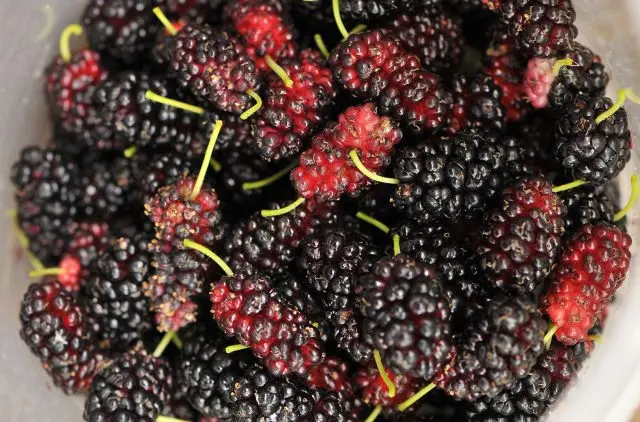
The mulberry has a high yield. One tree brings up to 100 kg of fruit. Berries are stored for no more than 2 – 3 days, after which they release a lot of juice and deteriorate. The crop is not subject to long transportation, so the fruits of mulberry should be used immediately after harvest.
Reproduction
For reproduction of mulberry, the following methods are chosen:
- Seeds. For planting use fresh mulberry seeds. Work starts in October. Achenes are cleaned and kept for 3 hours in water with the addition of a growth stimulator. Then they are planted in the ground. If planting is scheduled for spring, then the material is stratified. Seeds are planted to a depth of 3 cm, a layer of mulch is poured on top. Seedlings are watered and fed. Mulberries can be planted out in autumn. Fruiting of seedlings will begin in the 5th year. The disadvantage of this method is that the tree does not always inherit the characteristics of the parent variety.
- Cuttings. In June, cuttings 20 cm long and 3 buds are cut. They are planted in a greenhouse, where they create high humidity. Cuttings will be able to take root until autumn, but they are transferred to open ground only the next year.
- Root cuttings. The shoots that appear at the base of the mulberry tree can be separated and transplanted to a new place. At the same time, the signs of the mother are completely preserved in the new plant.
Diseases and pests
Black mulberry has a high immunity to fungal diseases. The culture is most susceptible to powdery mildew, brown spot, bacteriosis. The main signs of disease are manifested in the appearance of dark, yellow or whitish spots on the leaves of the mulberry tree, as well as in their fall. To combat lesions, Silit, Phytoflavin, Bordeaux liquid are used.
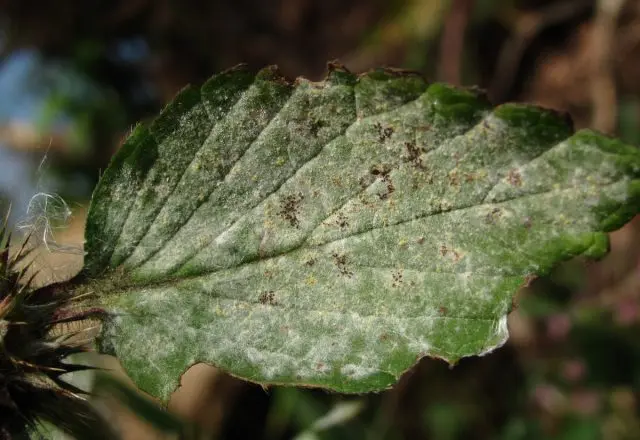
The mulberry attracts moth, white butterfly, spider mite. Against pests, insecticides Actellik, Chlorophos, Kleschevit are used. For prevention, fallen leaves are annually removed and burned, in which insects can often hibernate.
Black Mulberry Recipes
Homemade preparations will help preserve the beneficial properties of black mulberry. Jam, marmalade, compote, marmalade, wine are obtained from the mulberry tree. Fresh or processed berries are added to desserts, smoothies, pastries. They go well with pear, plum, peach, raspberry, yogurt, cream cheese.
A simple recipe for mulberry jam:
Ingredients:
- ripe berries – 1 kg;
- sugar – 1,3 kg;
- lemon – 3 pcs.
Sequence of preparation:
- Lemons, along with the peel, are scrolled through a meat grinder. Then fruits and sugar are poured.
- The mass is covered with a lid and kept for 3-4 hours so that juice stands out from it.
- Put the saucepan on the stove, turn on medium heat and bring to a boil.
- After the jam is cooled, then again put on fire and boil for 30 minutes. The whole procedure is repeated again.
- The hot product is distributed into jars and closed with lids.
To get jam, the berries are also scrolled in a meat grinder. Then put the resulting mass on fire and cook until tender.
Ingredients for preparing 2 liters of mulberry compote:
- mulberry – 1 kg;
- granulated sugar – 350 g;
- water – 650 ml;
- citric acid – 1 g.
The procedure for preparing mulberry compote:
- Ripe berries are gently washed with warm water.
- The stalks are removed from the mulberry fruits.
- The jar is washed with water and soda and heated in the oven.
- Prepared fruits are poured into the container.
- A syrup is put on fire, consisting of water, sugar and citric acid. The composition is brought to a boil, then pour the berries in jars.
- Banks with compote are pasteurized in a water bath for 20 minutes and canned for the winter.
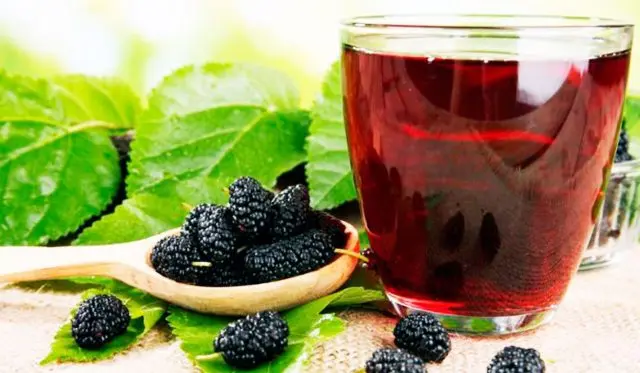
To get black mulberry marmalade, you need:
- ripe fruits – 1 kg;
- sugar – 500
Instructions for making mulberry marmalade:
- The mulberry is washed and cleaned from the stalks. Then rub through a sieve to separate the seeds.
- Sugar is poured into the resulting mass and put on a strong fire.
- Marmalade is boiled until thickened, stirring constantly.
- Ready marmalade is laid out in jars.
Ingredients for making homemade black mulberry wine:
- mulberry – 1 kg;
- water – 0,5 l;
- granulated sugar – 150 g;
- Cinnamon – 5 g;
- white wine – 100 ml.
The process of making wine from mulberry consists of the following steps:
- Mulberry berries are removed in dry weather, when they reach a black color. The fruits are washed and left to dry for a day.
- Juice is squeezed out of black mulberry in any convenient way: about 1 ml of juice is usually obtained from 500 kg of the crop.
- Mix an equal amount of mulberry juice and water, add cinnamon and sugar.
- The liquid is poured into jars. At the same time, make sure that a quarter of the volume of each can remains free.
- A water seal is installed on the neck, which can be made from a medical glove with a perforated finger. The contents are left to ferment for a week.
- The raw material is filtered, then white wine is added to it.
- The drink is kept for 2 weeks in a dark place at a temperature of 15 – 25 ° C: When fermentation ends, the glove deflates. The wine is poured into the bottle with a straw, without touching the sediment at the bottom.
- The bottle is hermetically sealed, a water seal is installed and young black mulberry wine is kept in a dark place at 16 оC. At this time, it is necessary to check the sediment and periodically get rid of it by pouring into another bottle.
Conclusion
Black mulberry is an unpretentious and productive crop. Its value lies in the fruits, leaves and bark, which have medicinal properties. The tree is not demanding on external conditions, but a good harvest is obtained with constant care for it.










